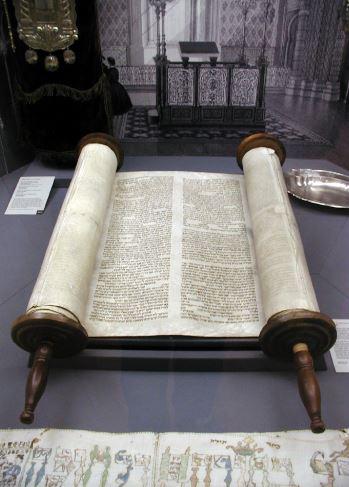Torah

📜 What Is the Torah?
The Torah (Hebrew: תּוֹרָה) is the most sacred text in Judaism — the foundation of Jewish faith, law, and life. The word Torah means “teaching,” “instruction,” or “guidance,” rather than just "law" (which is a common mistranslation).
📘 What Does the Torah Contain?
1. The Five Books of Moses
These five books make up the written Torah (Torah Shebikhtav):
| Hebrew Name | English Name | Overview |
|---|---|---|
| Bereshit | Genesis | Creation, the patriarchs (Abraham, Isaac, Jacob), and Joseph |
| Shemot | Exodus | The Exodus from Egypt, the Ten Commandments |
| Vayikra | Leviticus | Priestly laws, purity, sacrifices |
| Bamidbar | Numbers | Wilderness journey, censuses, struggles of the Israelites |
| Devarim | Deuteronomy | Moses’ final speeches and restatement of the law |
📖 More Than a Book — A Living Guide
The Torah is not just an ancient text — for Jews, it's:
-
Divine revelation — God's word given to Moses
-
A living tradition — studied, interpreted, and lived through generations
-
The center of religious life — read publicly in synagogues every week
Each week, a portion (parashah) is read so that the entire Torah is completed annually.
✍️ Written Torah vs. Oral Torah
| Written Torah | Oral Torah |
|---|---|
| Five Books of Moses | Interpretation, explanation, application of Torah |
| Fixed biblical text | Eventually recorded in the Talmud |
| Law, history, commandments | Discussions, debate, ethics, details |
Jewish tradition holds that both were given at Sinai and are equally sacred.
🌟 Spiritual Meaning of the Torah
-
The Torah is a path to encounter the Divine.
-
It teaches values like justice, compassion, humility, and responsibility.
-
It provides rituals and structure for a holy life — from prayer and food to holidays and family.
In Jewish mysticism (like the Kabbalah), the Torah is even seen as the spiritual blueprint of creation — every letter is holy, and every word carries hidden meaning.
🕍 The Torah in Jewish Life
-
Read aloud in the synagogue from a handwritten scroll.
-
Central to Jewish ceremonies, festivals, and holidays.
-
The Torah ark (Aron HaKodesh) in a synagogue holds the scrolls and symbolizes the covenant between God and Israel.
📚 The Torah in Other Religions
-
Christianity: The Torah forms the beginning of the Old Testament, but is interpreted differently.
-
Islam: The Tawrat (Torah) is considered a divine scripture given to Moses, though Muslims believe the original text was later changed.
🌍 The Creation Story in the Torah
📖 Genesis 1:1–2:3 — The Seven Days of Creation
The first creation story is structured and poetic, unfolding in seven days:
| Day | Creation |
|---|---|
| 1 | Light; separation of light from darkness |
| 2 | Sky (firmament); separation of waters above and below |
| 3 | Land, sea, and all vegetation |
| 4 | Sun, moon, and stars |
| 5 | Birds and fish |
| 6 | Land animals and human beings — created in God's image |
| 7 | God rests — the origin of the Sabbath (Shabbat) |
"And God saw everything that He had made, and behold, it was very good." – Genesis 1:31
📖 Genesis 2:4ff — The Second Creation Account
This version is more personal and symbolic:
-
God forms Adam from the dust of the earth and breathes life into him.
-
He plants the Garden of Eden, with the Tree of Life and the Tree of Knowledge.
-
He creates animals and then Eve, from Adam’s side, as a companion.
-
This sets the stage for the story of human freedom, choice, and the Fall.
✨ Spiritual Dimensions
-
Humanity is created in the image of God — every person has inherent dignity.
-
Creation is not random; it is good, ordered, and intentional.
-
The seventh day (Shabbat) is sanctified — time itself becomes spiritual.
-
Two creation accounts show:
-
Chapter 1: the cosmic aspect
-
Chapter 2: the relational and inner dimension
-
🧠 Deeper Interpretations
-
Rabbinic commentaries (Midrash) see layers of ethical and symbolic meaning.
-
Kabbalistic teachings view creation as a process of divine light unfolding through vessels (sefirot).
-
Many Jewish thinkers see the Torah’s creation story as metaphor, mystery, or spiritual map, not literal science.
🔠 First Verse of the Torah (Hebrew & English)
Hebrew:
בְּרֵאשִׁית בָּרָא אֱלֹהִים אֵת הַשָּׁמַיִם וְאֵת הָאָרֶץ
Transliteration: Bereshit bara Elohim et hashamayim ve’et haaretz
English: "In the beginning, God created the heavens and the earth."
🔁 Final Thoughts
The Torah is not just a book — it’s a living covenant, a spiritual guide, and the heart of Jewish identity and connection with the Divine.

